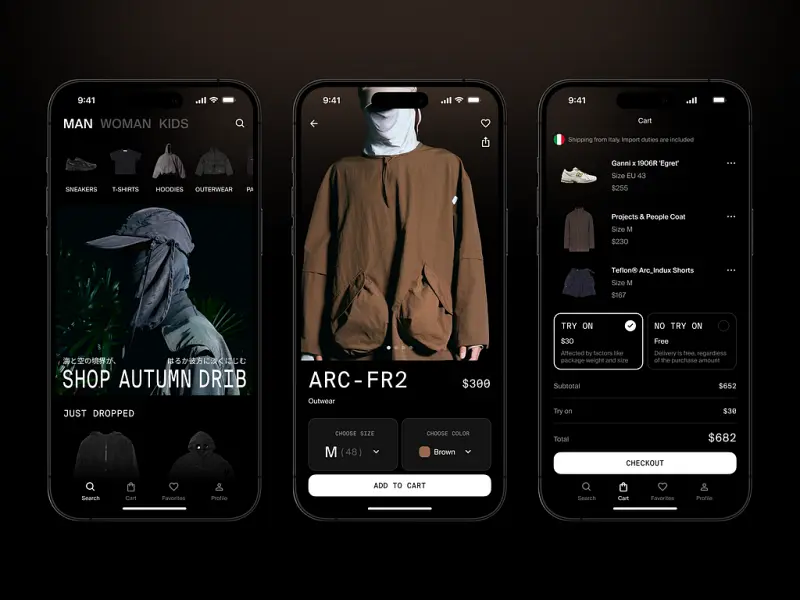Digital Transformation in Retail Industry – Everything You Need to Know


The retail industry has changed a lot over the past decade. New technologies, shifts in customer habits, and ideas for reducing inefficiencies have all contributed. The COVID-19 pandemic has accelerated these changes even more.
Research from Gartner indicates that over 50% of consumer spending will be online in 2024, with 60% occurring through mobile devices. Retailers focusing on mobile experiences and embracing digital changes will thrive and grow. In this guide, we explore key elements and delve into the essentials of Digital Transformation in Retail Industry.
Retail digital transformation involves using technology in the retail industry to boost operations, improve customer experiences, and support growth. This transformation covers personalized shopping experiences, POS systems, self-checkout systems, VR showrooms, branded mobile apps, cost optimization, geofencing, and AI-powered product recommendations.

Digital Transformation
Digital transformation covers many aspects for retailers. Focusing on where people and systems interact ensures benefits for workers, customers, and the business. Let’s look at some key areas.
Omnichannel shopping combines physical and digital channels to provide a seamless shopping experience. This is important because shoppers use an average of six touchpoints when deciding on a purchase. They research and compare products before making informed decisions.
US retailer Target found that multi-channel customers spend four times more than in-store customers and ten times more than digital-only ones.
Data drives decision-making in retail. Successful retailers use data effectively, which benefits their operations and customers who are searching for the right products.
Retailers should use data analytics to understand consumer behaviors and preferences. This helps decide what to sell, how, and to whom. It also allows for personalized shopping experiences.
Data should be accessible to those who need it most. Consumers have access to information all day, but this often stops when they enter a store.
For workers, real-time access to inventory and customer data can enhance daily tasks and improve customer assistance.
Using technology to automate manual tasks can greatly improve efficiency. It enables employees to concentrate on more critical tasks, like better-serving customers.
Automation is most effective for repetitive, error-prone, and time-consuming processes. It helps streamline inventory management and order fulfillment, reducing costly mistakes.
Retail and digital transformation offers several significant benefits. Let’s explore one of them:
Analyzing consumer data can generate valuable market insights. These insights help retailers outline specific actions and strategies to boost growth and profitability. They also enable retailers to understand their customers better and build strong relationships, which is crucial for driving growth.
Retailers can segment customers, analyze their buying behavior, set the right strategies, and trigger personalized communications and promotions.
For example, a fitness enthusiast regularly buys health supplements from a retailer. The retailer can use data and insights to create a personalized promotional campaign for health supplements to increase purchase frequency and retention.
Target, the 7th largest retailer in the U.S., uses advanced technology like artificial intelligence, machine learning, and predictive analytics. These tools help Target understand customer needs based on past purchases, enhancing customer experience and enabling mass personalization. This leads to higher customer retention.

Benefits of digital transformation in the retail industry
Digital transformation enables retailers to collect customer data and create targeted marketing campaigns. Technologies like CRM, data analytics, and marketing automation assist in recognizing patterns and trends, giving valuable insights into target audiences. This access to information reduces marketing costs and allows for adjustments to campaigns based on changing consumer behavior.
Technology and data make inventory management more efficient in retail. Digital technologies streamline and automate inventory processes. This transformation boosts operational efficiency, speeds up order fulfillment, improves warehouse management, and helps determine lead times and safety stock to avoid stock-outs.
Digital transformation helps retailers create an omnichannel customer experience. Customers can receive support through various channels, such as websites, mobile apps, email, and live chat. Digital transformation offers self-service options, like chatbots, for customers to address their queries and grievances anytime. This technology provides real-time personalized customer service, allowing customers to navigate their journey with minimal interactions, increasing retailers’ cost efficiency.
Have a Project Idea in Mind?
Get in touch with experts for a free consultation. We’ll help you decide on next steps, explain how the development process is organized, and provide you with a free project estimate.
Emerging technology is transforming how enterprise retailers operate. Here are a few significant examples:
Modern POS systems like NCR, Lightspeed Retail, iQmetrix, and Square now offer real-time inventory management, sales tracking, and customer data analysis using cloud computing, AI, and data analytics.
These systems help retailers make quick decisions, improve inventory turnover, and reduce waste. Mobile POS systems enhance customer service by enabling transactions anywhere in the store. They integrate with CRM and ERP systems for efficient workflows.
Modern POS systems personalize customer experiences with AI-driven recommendations and consistent shopping across online and offline platforms. They offer more profound insights into customer behavior and ensure secure transactions.
For large-scale retailers, these systems are crucial for strategic decisions, operational efficiency, and customer relationship management, marking a significant leap in digital transformation.
Retailers can customize their offerings using data analytics and machine learning to meet individual customer preferences. This enhances the shopping experience and builds loyalty. Customization, seen in online browsing, targeted promotions, and in-store interactions, boost customer engagement and purchase likelihood. This is vital for large retailers to stay competitive and connect with customers.
For enterprise retailers, AI-driven personalization is key to digital transformation. It increases conversion rates and average order values, providing insights for inventory and marketing optimization. As data analysis continues, the effectiveness of personalized experiences improves. Advanced personalization is crucial for large retailers adapting to changing consumer behaviors and market dynamics.
AR/VR and augmented overlay technology are changing how customers shop. Retailers use these technologies to offer digital projections of products. This helps customers see how items will look in their homes or on themselves. Examples include:
These technologies offer interactive and personalized shopping experiences. They enhance customer engagement and satisfaction.
Major retailers like Target, Walmart, Urban Outfitters, and Best Buy have custom mobile apps that customers can download to their smart devices. This benefits both customers and retailers. Customers receive app-exclusive deals and rewards, and retailers gain a new channel to communicate, market, and sell directly to customers.
As digital transformation benefits retailers in several ways, technologies are still evolving. Here are a few digital trends to watch:
AR technology lets customers visualize products in their own spaces. For example, Target’s mobile website has a feature called “See It in Your Space.” This allows customers to view furniture in their homes from a 3D perspective.
Amazon has teamed up with L’Oreal to use AR for beauty products. Customers can try different lipstick shades Through the Amazon app to see which colors suit them best. Currently, only lipstick is available, but more beauty products will be added.
Retailers today are using big data to understand their customers better. Modern customers expect a personalized and efficient shopping experience. Retailers meet this demand using predictive and prescriptive analytics, which allow them to manage inventory, merchandising, and procurement strategies.
Decisions informed by big data help retailers get a better return on investment.
Customers engaged in retail and digital transformation and online touchpoints will likely become more valuable to retailers. An omnichannel strategy involves connecting and synchronizing business transactions with customers via different channels such as social media, emails, and websites. This approach helps create a seamless shopping experience.
Home Depot, a home improvement retail corporation, has created a personalized omnichannel shopping experience through click-and-collect and personalized marketing offerings.
IoT helps retailers track and collect data more efficiently, including point-of-sale, supply chain planning, and inventory management. It also allows retailers to offer real-time product promotions based on behavior insights. Conversion rates increase through upselling and cross-selling using consumer data and purchase history insights.
Retailers use blockchain technology for its enhanced security, efficiency, and transparency. Blockchain applications in retail extend beyond digital payments. It tracks products in the supply chain and stores information in a decentralized ledger.
Nestle started using blockchain technology in 2017. The company uses it to streamline and standardize product tracking. Nestle has expanded blockchain technology to its Swedish coffee brand Zoegas.
GenAI chatbots are revolutionizing retail by enhancing personalized customer experiences and streamlining operations. They provide 24/7 customer support and personalized product recommendations, improving satisfaction and engagement. By automating routine tasks, chatbots free up human staff and optimize inventory management through demand predictions.
In marketing, AI helps create targeted campaigns and gain insights into customer behavior, leading to more effective strategies. Chatbots ensure a seamless omnichannel experience by integrating services across platforms, enhancing the overall shopping journey. This drives innovation and supports digital transformation, making them a key trend in the retail industry.
Got a Vision for GenAI Chatbot Development?
Reach out to our expert team for a free consultation. We’ve successfully delivered a cutting-edge GenAI chatbot for a major client, and we’re ready to help you navigate the development process, clarify the next steps, and provide you with a precise project estimate.
Here are some obstacles faced during digital transformation in retail industry:
Investing in technology is crucial for digitalization and requires significant financial resources. Retailers must carefully plan and decide where to allocate funds. They must consider how different technologies will work together and how these changes will impact the business. The costs are not just about purchasing new tools and systems. Implementation, downtime, and training also add to the expenses. All these factors need to be accounted for in the overall transformation project.

Example of Retail Digital Transformation
Many retailers depend on old systems for their main operations. Some of these systems have been used for more than 20 years. Over time, extra capabilities have been added to meet market needs, making the systems more complex. This complexity makes it hard to have a simple architecture and to ensure new technology works well with the old systems. Replacing these systems or finding ways to make old and new systems work together will need a lot of time and resources.
Changes will impact everyone involved with a retailer. Workers and customers are often the most resistant to transformation projects. Clear communication is essential to achieve success and ensure new tools are adopted. Involving workers and customers in testing and rolling out new systems helps gain their support. Agile and fail-fast methods allow retailers to try new things and get feedback quickly, which can help reduce resistance.
Retail digital transformation projects may need new talent with the skills to implement and manage new technology. Training existing workers on new processes and tools requires time, money, and effort. This should not be underestimated.
Adopting digital transformation in retail industry is crucial for retailers to remain competitive in the current market. The benefits are immense, from personalized shopping experiences and AR/VR showrooms to advanced POS systems and automation. Data analytics, IoT, and blockchain technologies further empower retailers to make informed decisions and build customer loyalty.
Don’t navigate digital transformation alone. TECHVIFY provides the best consultation and solutions tailored to your needs. Contact TECHVIFY today, and let’s revolutionize your retail business together!
TECHVIFY – Global AI & Software Solutions Company
For MVPs and Market Leaders: TECHVIFY prioritizes results, not just deliverables. Reduce time to market & see ROI early with high-performing Teams & Software Solutions.


Table of ContentsI. Definition of Digital Transformation in Retail IndustryII. Most Important Elements of Retail Digital TransformationOmnichannel ShoppingData AnalyticsAutomationIII. Digital Transformation Is Improving Retail Sales, Here’s HowProvides Market InsightsIncreased Customer RetentionImproves Marketing CampaignsSimplifying Inventory ManagementEnhancing Customer ServiceIV. Examples of Impactful Retail Digital Transformation1. POS Systems2. Customized Shopping Experiences3. AR/VR Showrooms4. Branded Mobile AppsV. Trends in Retail and Digital TransformationAugmented Reality (AR)Insights from Big DataOmnichannel RetailingEfficient Data Collection with IoTBlockchain in RetailGenAI chatbotsVI. Challenges in Retail Digital TransformationCost ChallengeLegacy Systems ChallengeReluctance to Change Workforce SkillsConclusion In the fast-evolving world of online dating, understanding the cost to build a dating app is vital…
22 October, 2024

Table of ContentsI. Definition of Digital Transformation in Retail IndustryII. Most Important Elements of Retail Digital TransformationOmnichannel ShoppingData AnalyticsAutomationIII. Digital Transformation Is Improving Retail Sales, Here’s HowProvides Market InsightsIncreased Customer RetentionImproves Marketing CampaignsSimplifying Inventory ManagementEnhancing Customer ServiceIV. Examples of Impactful Retail Digital Transformation1. POS Systems2. Customized Shopping Experiences3. AR/VR Showrooms4. Branded Mobile AppsV. Trends in Retail and Digital TransformationAugmented Reality (AR)Insights from Big DataOmnichannel RetailingEfficient Data Collection with IoTBlockchain in RetailGenAI chatbotsVI. Challenges in Retail Digital TransformationCost ChallengeLegacy Systems ChallengeReluctance to Change Workforce SkillsConclusion You’ve started a business, and now you need a website. But no one on your team knows…
21 October, 2024

Table of ContentsI. Definition of Digital Transformation in Retail IndustryII. Most Important Elements of Retail Digital TransformationOmnichannel ShoppingData AnalyticsAutomationIII. Digital Transformation Is Improving Retail Sales, Here’s HowProvides Market InsightsIncreased Customer RetentionImproves Marketing CampaignsSimplifying Inventory ManagementEnhancing Customer ServiceIV. Examples of Impactful Retail Digital Transformation1. POS Systems2. Customized Shopping Experiences3. AR/VR Showrooms4. Branded Mobile AppsV. Trends in Retail and Digital TransformationAugmented Reality (AR)Insights from Big DataOmnichannel RetailingEfficient Data Collection with IoTBlockchain in RetailGenAI chatbotsVI. Challenges in Retail Digital TransformationCost ChallengeLegacy Systems ChallengeReluctance to Change Workforce SkillsConclusion With much of our communication happening online, it’s no surprise that the dating world has also shifted…
18 October, 2024


Thank you for your interest in TECHVIFY Software.
Speed-up your projects with high skilled software engineers and developers.
By clicking the Submit button, I confirm that I have read and agree to our Privacy Policy